World Climatic Regions
Understanding climate holds tremendous significance as it profoundly influences human life, activities, and the geographical features of a region. Climate exerts a profound impact on the flora and fauna of a landscape, playing a pivotal role in determining their distribution and existence. To better comprehend the varied climates, it is crucial to categorise them into major groups based on shared, critical characteristics.

CLIMATIC REGIONS OF WORLD

HOT WET EQUATORIAL CLIMATE
Geographical Distribution
- Spans from 50 degrees North to 100 degrees South from the equator, characterised by an absence of trade wind impact; areas further from the equator typically exhibit a monsoon-type climate.
- While predominantly hot and wet, certain high-altitude places like Cameron Highlands in Malaysia offer cooler temperatures.
- Some Notable Countries: Ecuador, Colombia, Brazil, Peru, Nigeria, Liberia, Myanmar, Thailand, Cambodia, Malaysia, Java.

Climate
- Consistent, almost uniform temperature levels are maintained throughout the year, averaging between 24 to 27ºC, with minimal variations; no distinct winter season.
- Marginal fluctuations in daily and yearly temperature ranges.
- Heavy, well-distributed precipitation ranges between 60 to 100 inches annually.
- Distinctive double rainfall peaks coincide with the equinoxes.
Natural Vegetation
- Supports a thriving tropical rainforest known for its lush vegetation.
- The Amazon tropical rainforest, also called Selvas, is distinguished by a myriad of evergreen trees, producing tropical hardwood like mahogany, ebony, greenheart, cabinet wood, and dyewoods.
- Abounds in lianas, epiphytic, and parasitic plants.
- Rarely features single-species dominant trees within its expanse.
Economy
- Equatorial regions are generally thinly populated.
- Forest inhabitants often follow traditional hunting, gathering, and shifting cultivation practices.
- Some areas practise plantation farming cultivating crops such as natural rubber, cocoa, and other plantation crops.
TROPICAL WET AND DRY SAVANNA AND SUDAN CLIMATE
- The Savanna Climate, also known as the Sudan climate, is a transitional climate type situated between equatorial forests and hot trade wind deserts.
- It covers regions within the tropics and is notably developed in Sudan, where distinct dry and wet seasons contribute to its name.
- The climate extends across various continents, including Africa (Kenya, Nigeria, Gambia), South America (Brazilian highlands), and India.
Geographical Distribution
- Spans from the Tropic of Cancer to the Tropic of Capricorn, particularly well developed in Sudan.
- In the Northern Hemisphere, it's found in African and South American regions.
- In the Southern Hemisphere, it stretches across South America and Australia.
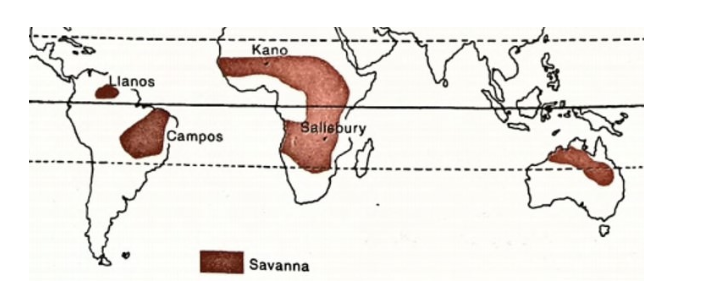
Temperature
- Monthly temperatures vary between 20 to 32 degrees Celsius in lowlands, increasing as distance from the equator grows.
- The annual average temperature hovers around 18 degrees Celsius.
- Highest temperatures occur just before the rainy season (April in the northern hemisphere and October in the southern hemisphere).
- Overcast skies during the rainy season lead to decreased temperatures.
- Midday temperatures often surpass 37 degrees Celsius during the hot season.
- Clear skies result in rapid nocturnal temperature drops, even below 10 degrees Celsius, common during the hot season.
- Distinctive diurnal temperature variations are a characteristic feature.
Precipitation
- Marked by a hot, rainy season and a cool, dry season.
- In the northern hemisphere, the wet season runs from May to September.
- The rest of the year is dry and cool, experiencing over 80 cm of rainfall concentrated in the summer.
- In the southern hemisphere, the rainy season lasts from October to March.
- Rainfall and duration decrease as one moves toward desert fringes.
Winds
- Trade winds are prevalent in this region and bring rainfall to coastal areas.
- These easterly winds move from east to west, resulting in maximum rainfall on the east coasts.
- The trade winds are strongest in summer, exhausting moisture along coastal areas and leaving the continental interiors relatively dry.
- In West Africa, easterly trade winds bring dust-laden, dry winds from the Sahara, termed Harmattan, to the coast of Guinea.
Vegetation
- Tall grasslands with shorter trees, also described as 'bush-veld' or 'parkland'.
- Trees are more abundant towards the equator and riversides, reducing in density away from the equator.
- Deciduous trees shed leaves to conserve water during dry seasons.
- Other trees serve as water storage during drought. E.g., baobabs, bottle trees.
- Tall, coarse grasses, like elephant grass, dominate the region.
Wildlife
- Home to a variety of herbivores and carnivores, including zebra, giraffe, lion, and hyena.
- Along rivers and marshy lands, reptiles like crocodiles and giant lizards can be found.
Economy
- Region's economy includes nomadic pastoralists and settled agricultural tribes.
- Plantation agriculture, including cotton, sugarcane, and tropical fruits, showcases the agricultural potential.
- Some regions struggle with soil degradation, leaching nutrients, and difficulty supporting large-scale animal ranches.
TROPICAL MONSOON CLIMATE
- Monsoon Climate, also known as Tropical Monsoon Climate, is a weather system existing between the Tropic of Cancer and the Tropic of Capricorn.
- The region is significantly affected by the inter-tropical convergence zone (ITCZ) and remains hot and humid throughout the year due to the sun's overhead position.
- The climate is marked by seasonal winds known as monsoons, causing temperature and precipitation changes.
Geographical Distribution
Located within 5–30 degrees latitudes on both sides of the equator.
Regions experiencing this climate include the Indian subcontinent, Indo-China (Laos, Vietnam, Cambodia), Thailand, southern China, and northern Australia.
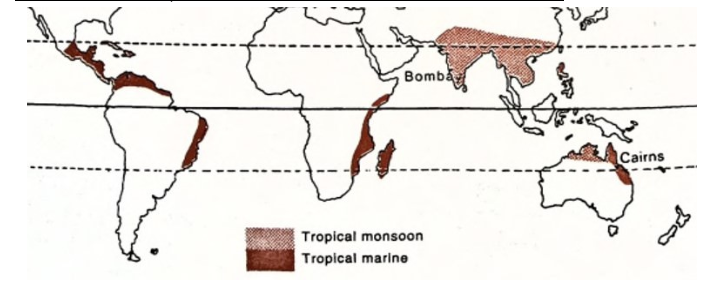
Winds
- Monsoon winds exhibit a seasonal shift in direction due to differential heating and cooling of landmasses and seas.
- During summer, the low-pressure area over Central Asia causes the Asian landmass to heat more rapidly than surrounding seas, generating the South-West monsoon winds.
- Winter brings about a high-pressure zone over northern Australia, leading to a reversal in wind direction.
Temperature
- Warmer temperatures prevail due to the region's proximity to the tropics.
- Monthly averages range above 18 degrees Celsius, reaching up to 45 degrees Celsius in summer.
- Winters are milder, around 15 to 30 degrees Celsius.
- Diurnal temperature variations are observed.
Precipitation
- The region experiences intense rainfall, concentrated in specific months.
- Annual average rainfall ranges from 200-250 cm, reaching even 350 cm in some areas.
- Certain areas, like Mawsynram and Cherrapunji in India, witness exceedingly high rainfall due to the orographic lift of monsoon winds against hills.
Seasons
- Three distinct seasons exist in the monsoon climate: hot dry season, rainy season, and cold dry season.
- The hot dry season, occurring from March to mid-June, features high temperatures, minimal rainfall, and occasional thunderstorms.
- The rainy season, from mid-June to September, sees monsoon bursts resulting in over 70 percent of the region's yearly rainfall.
- The cold dry season, from October to February, marks the retreat of monsoon winds and occasional rains, particularly in coastal areas.
Monsoon Forests
- These forests, also called Tropical Monsoon Forests, comprise deciduous trees adapted to the shedding of leaves during dry seasons to conserve water.
- Moist and dry deciduous forests exist, varying based on annual rainfall.
- The vegetation ranges from dense forests to savanna-like areas, reflecting the rainfall's abundance or scarcity.
Economy
- Regions with monsoon climates have higher population density.
- Agriculture, including subsistence farming, shifting cultivation, and plantation agriculture, is common.
- Crops cultivated include rice, wheat, maize, jute, sugarcane, and spices.
- Plantation crops like tea, coffee, rubber, and bananas are grown in highland regions.
- Timber production, especially of durable hardwoods like teak, is significant.
- This climate holds vital significance for the economy, agriculture, and natural biodiversity in the regions it affects.
DESERT CLIMATE
- Desert regions are identified by minimal rainfall and sparse vegetation, with a limited growing period typically occurring during a brief rainy season.
- These areas are further classified into hot and mid-latitude deserts, each possessing distinct characteristics.
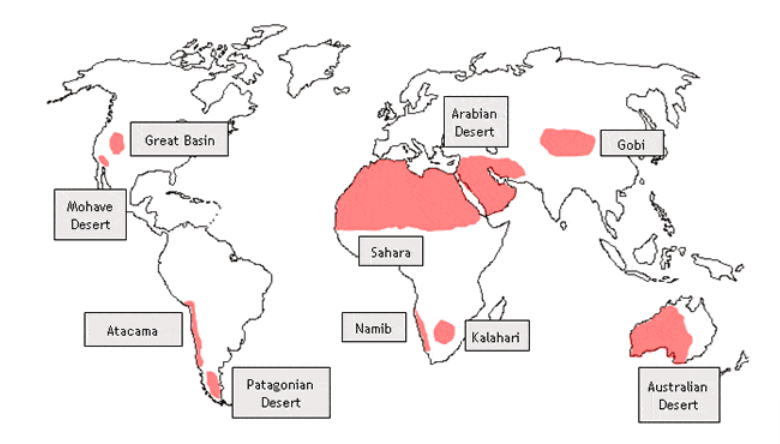
Hot Deserts - Distribution
- Located on the western edges of continents between latitudes 15 to 30 degrees north and south.
- Prominent hot deserts include the Sahara, Great Australian Desert, Arabian Desert, Kalahari Desert, and Thar Desert.
- Notable North American hot deserts are Mohave, Sonoran, Californian, and Mexican deserts, while the Atacama Desert is in South America.
Hot Deserts - Climate and Temperature
- Among the hottest places on Earth, experiencing consistently high temperatures throughout the year.
- Lack a distinct cold season, with average summer temperatures consistently exceeding 30 degrees Celsius.
- Significant diurnal temperature fluctuations due to clear skies and rapid heat loss at night.
- Inland areas witness extreme temperatures, while coastal regions exhibit a relatively moderate climate due to the influence of cold currents.
Hot Deserts - Precipitation
- Annual precipitation rarely exceeds 25 cm, primarily due to descending air masses and a lack of moisture-laden winds.
- Trade winds blow offshore, hindering moisture from reaching these regions.
- Relative humidity decreases inland, causing increased evaporation and minimal precipitation, leading to a state of permanent drought.
- Despite the arid climate, sudden, short-lived, and intense thunderstorms occasionally occur, with the Atacama Desert being the driest region on Earth.
Mid-Latitude Deserts - Distribution and Climate
- Situated on plateaus and continental interiors, including the Gobi Desert, Turkestan Desert, and Patagonian Desert.
- These deserts experience similar climatic conditions to hot deserts, as they are far from moisture-laden winds.
- Average annual precipitation remains below 25 cm, with occasional rainfall during depressions and summers.
- The phenomenon of continentality, typical for regions far from coastal influences, leads to extreme temperature fluctuations.
Desert Vegetation and Life
- Deserts host vegetation such as xerophytic scrub, adapted to survive arid conditions.
- Characteristic plant species include cacti, wiry grasses, thorny bushes, and acacia.
- Vegetation exhibits special adaptations such as reduced leaves, waxy surfaces, and well-developed root systems to minimise water loss.
- Human settlements vary from primitive hunter-gatherer tribes to nomadic herders and settled cultivators, who inhabit regions close to rivers for agricultural purposes.
- Some desert regions are utilised for mining, with notable sites for various resources such as gold, diamonds, copper, silver, and oil.
- Deserts support varied forms of life, displaying an array of human settlements and adaptations to survive the extreme arid conditions prevalent in these regions.
STEPPE CLIMATE
- The term "steppe" describes a semi-desert region characterised by grassland or shrub vegetation.
- Steppes, also known as Temperate Grasslands, are intermediary regions between forests and deserts, lacking the necessary rainfall for forests but not as arid as deserts.
- These regions are known for their fertile agricultural landscapes and vast grasslands, earning them the title of "grain baskets."
Distribution
- Situated in continental interiors within temperate latitudes and influenced by Westerly winds.
- Recognizable by vast treeless grasslands and known by various regional names such as Prairies in North America, Pustaz in Hungary, Pampas in Argentina and Uruguay, Velds in South Africa, Downs in Australia, and Canterbury in New Zealand.
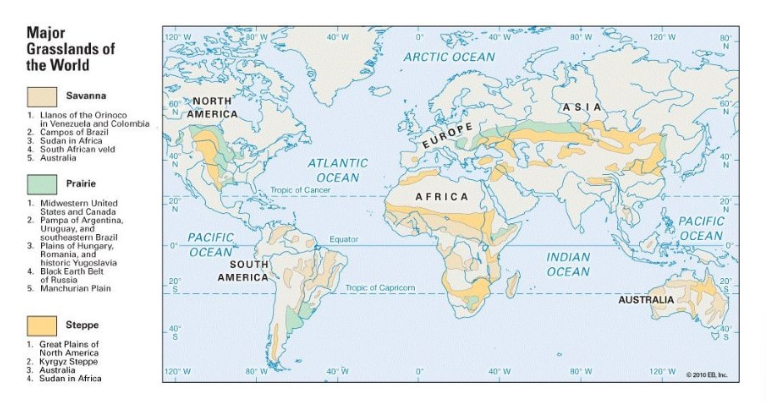
Precipitation
- Annual rainfall ranges from 25 to 75 cm, varying by region. The highest precipitation usually occurs in the spring or before summer.
- Winters bring occasional depressions, often resulting in snowfall.
- Southern hemisphere steppes typically receive higher rainfall due to increased maritime influence compared to northern hemisphere regions.
Temperature
- Seasonal temperatures fluctuate due to continentality, with warm summers averaging 18-20 degrees Celsius and cold winters featuring occasional snowfall.
- Northern hemisphere steppes exhibit greater annual temperature ranges, while southern hemisphere regions maintain a moderate climate due to maritime influence.
Winds
- Westerlies are the prevailing winds, responsible for winter precipitation.
- Local winds like Mistral, Loo, Sirocco, Foehn, and Chinook impact regional climates, providing specific weather changes and agricultural benefits.
Vegetation
- Unlike tropical grasslands, temperate grasslands are mostly treeless, featuring fresh and nutritious, albeit lean, grasses.
- Ideal for large-scale livestock rearing due to year-round grass growth and the absence of significant seasonal changes.
- Transitional zones near the poles might feature coniferous trees, while trees are planted around croplands to shield them from strong winds.
Economy
- Steppes showcase less animal diversity but support considerable horse riding in Eurasian steppes.
- Agricultural productivity is high, especially in prairies, due to extensive crop cultivation, aided by irrigation canals and mechanised farming.
- Wheat and maize are prominent crops, particularly in regions like the prairies, Pampas, and Downs, which are known for wheat cultivation.
- Steppes also excel in livestock ranching, rearing cattle and sheep on a large scale, producing dairy and animal products for global export.
- The nomadic herding tradition persists in certain Eurasian steppes, with long periods of drought making settled animal rearing challenging.
- Various grassland regions have become renowned for specific economic activities, such as wheat cultivation, livestock ranching, and the production of dairy, beef, wool, and other animal products. These regions contribute significantly to global agricultural production.
MEDITERRANEAN CLIMATE
The Mediterranean climate is characterised by distinctive features including dry, warm summers and wet, cold winters, primarily observed along the western margins of continents between 30° and 45° North and South of the Equator.
Distribution
- Found in regions like Central Chile, California, southwestern tip of Africa, southern Australia, and southwest Australia.
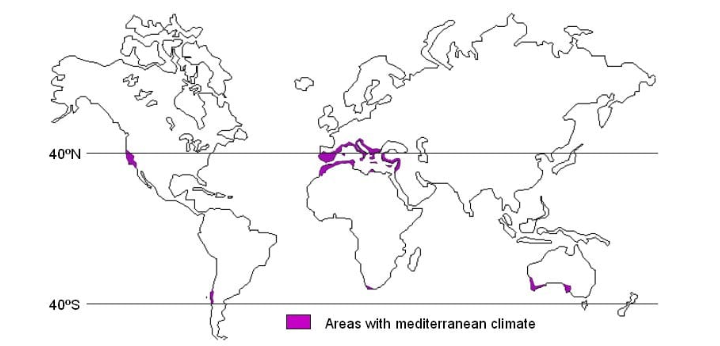
Climate
- Dry, warm summers: Offshore Trade Winds dominate summers, resulting in rainless conditions, intense heat, and low humidity, causing prolonged droughts in continental interiors.
- Wet, cold winters: Onshore Westerlies influence winters, providing the majority of precipitation. Heavy downpours often lead to floods in regions like Mediterranean Europe.
Local Winds
- Sirocco: Hot, dry wind from the Sahara desert, carrying red dust, and causing withering of vegetation when blowing into the Mediterranean.
- Mistral: Cold wind from the north, especially impacting the Rhone valley, known for high wind velocities and potential freezing temperatures.
- Other local winds like Bora, Tramontana, and Gregale affect the region.
Natural Vegetation
- Sparse vegetation with widely spaced, small broad-leaved trees struggling against dry conditions.
- Xerophytic vegetation includes evergreen forests, evergreen coniferous forests, bushes, shrubs, and grasses, often appearing in cooler highland regions.
Economic Development
- Orchards: Known for fruit cultivation like citrus fruits, olives, and various nut trees.
- Crop Cultivation: Cereals like wheat and barley are primary crops. Farmers utilize the climate's seasonal rhythm to their advantage.
- Sheep Rearing: Mountains support some livestock, with the practice of transhumance widespread.
- Wine Production: Viticulture thrives due to long, sunny summers allowing grapes to ripen. The Mediterranean regions contribute significantly to the world's wine production.
- The Mediterranean climate's unique weather patterns and regional influences shape diverse economic activities, especially in agriculture, fruit cultivation, crop production, livestock rearing, and the esteemed tradition of wine-making.
WARM TEMPERATE EASTERN MARGIN CLIMATE
- The warm temperate eastern margin climate, located between 20 and 35 degrees N and S latitude, shares similarities with the monsoonal climate.
- It features rain during summer and dry weather in winter. Variations include the China Type, Gulf Type, and Natal Type:
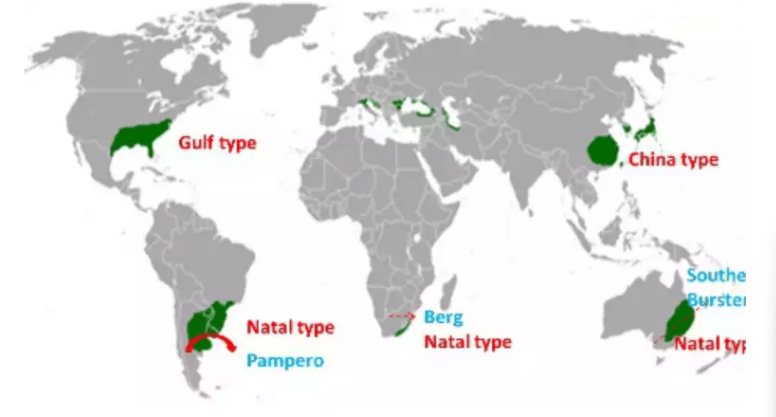
Climate
- Warm, moist summers and cool, dry winters are common.
- Rainfall ranges from 60 cm to 150 cm, evenly distributed throughout the year.
- Rain is sourced from conventional or orographic processes during summer and depressions during winter, with the occurrence of local storms like typhoons and hurricanes.
- Typhoons frequent the China Type, while the Gulf Type experiences hurricanes and violent tornadoes.
Natural Vegetation
- Heavier rainfall supports a rich variety of perennial plant growth.
- Lowlands feature evergreen broad-leaved forests and deciduous trees, similar to tropical monsoon forests, while highlands host various conifers like pines and cypresses.
Economic Development
- The regions are highly productive, as there is adequate rainfall and a nearly continuous growing season.
- Agriculture thrives in these regions. Monsoon China is a significant rice-growing area, while the Gulf States focus on corn, cotton, and tobacco.
- Corn and cotton are essential crops in the Gulf States, and the cultivation of tobacco is also significant. The humid climate, long growing seasons, and well-drained soils support their growth.
- Natal, Paraná-Paraguay-Uruguay basin regions grow cane sugar, cotton, tobacco, maize, and support cattle and sheep rearing.
Farming in Monsoon China
- Monsoon China is one of the world's greatest rice-growing regions, accounting for a substantial portion of global rice production.
- Paddy cultivation is a primary practice, demanding considerable labor and catering to a large population.
- Progress has led to increased rice production through double and treble cropping.
Agriculture in the Gulf States
- The Gulf States focus on corn, cotton, and tobacco. Corn production exceeds half of the world's total and is used to feed animals.
- Cotton thrives due to the warm, moist climate, with high-quality fibers contributing significantly to the region's economy.
- Tobacco cultivation is vital in this region and contributes substantially to international trade.
- Crop Cultivation in the Eastern Margins of the Southern Hemisphere
- Natal coastlands cultivate cane sugar, cotton, tobacco, and maize. The interior regions focus on cotton, tobacco, and maize.
- South America's rainfall supports cattle and sheep rearing, wool, hides, and meat production.
- Australia's coastal districts receive heavy rainfall, growing giant eucalyptus trees and producing dairy products, cotton, cane sugar, and maize.
BRITISH TYPE CLIMATE
- The British-type climatic regions, also known as the cool temperate western margin climate or North-west European Maritime Climate, are influenced by the Westerlies and high cyclonic activity.
- These regions include parts of North-West Europe, North America, and in the Southern Hemisphere, areas in Southern Chile, Southern Australia, Tasmania, and most parts of New Zealand.
Climate
- Moderately warm summers and mild winters with a small temperature range between 5°C and 15°C.
- Adequate rainfall throughout the year, influenced by the North Atlantic Drift and South-Westerlies.
- Four distinct seasons: long, sunny summers, gusty autumns, cloudy winters, and refreshing springs.

Natural Vegetation
- Deciduous forests are common, featuring trees shedding their leaves in the cold season.
- Species such as oak, elm, ash, birch, beech, hornbeam, and poplar, alongside willows, alder, and aspen in wetter areas.
- Logging is profitable due to the value of deciduous trees for lumber and other commercial purposes.
- Conifers replace deciduous trees at higher altitudes in the Scandinavian highlands, Rockies, southern Andes, and Southern Alps of New Zealand.
Economic Development
- Significant deforestation, with only a small percentage of the original forest in Britain remaining.
- Lumbering is profitable due to the high commercial value of trees.
- Agriculture is primarily for domestic consumption, and the region is a net importer of food crops.
Agriculture
- Market gardening is highly practised, driven by a large urban population's demand for fresh vegetables, meat, milk, and fruits.
- Intensive farming with high yields due to soil fertility and good transportation networks for perishable goods.
- Mixed farming involves both arable and pastoral farming, with wheat, barley, cattle, and sheep being important.
- Dairying is significant in New Zealand, known as one of the world's greatest exporters of dairy products.
- Sheep rearing, for wool and mutton, is prominent in the UK and New Zealand, with the latter being a major player in mutton and wool exports.
- Industrialization is substantial, with countries involved in machinery, chemical, and textile production. Regions like the Ruhr in Germany and Yorkshire, Manchester, and Liverpool in Britain are hubs for various manufacturing industries.
- Overall, the British-type climate regions are agriculturally productive, highly industrialised, and encompass diverse farming practices to meet the demands of their populations and international markets.
TAIGA CLIMATE
- The Taiga Climate, also known as the Cool Temperate Continental Climate, Boreal Climate, or Siberian Climate, is primarily found in the Northern Hemisphere.
- It's absent in the Southern Hemisphere due to the narrow land surfaces and strong oceanic influence that mitigates severe winters.
Distribution
- Spans from approximately 50°N to 70°N across central Canada, parts of Scandinavia, and central and southern Russia.
- Merges into the Arctic tundra in the northern part and transitions to temperate Steppe climate in the south.
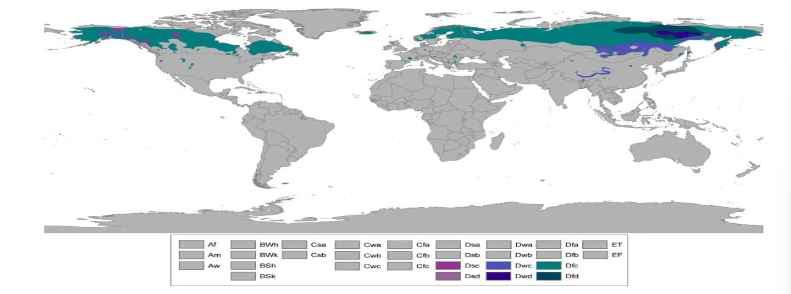
In the Southern Hemisphere, the strong oceanic influence reduces the severity of winters.
Climate
- Features extremely cold and long winters, with temperatures ranging from -30°C to -40°C.
- Summers are cool and brief, while spring and autumn are transitional periods.
- Annual temperature range is high, around 50°C to 60°C.
Precipitation
- Limited maritime influences result in low annual precipitation, roughly between 38cm to 63cm.
- Well-distributed rainfall throughout the year with a summer maximum due to convectional rain.
- Winter precipitation occurs as snow.
Natural Vegetation:
- Dominated by evergreen coniferous forests, well adapted to endure the harsh climate.
- Major species include pine, fir, spruce, and larch.
- Coniferous forests have commercial value due to their suitability for lumber and other purposes.
Economic Development
- The region is sparsely populated due to extreme conditions.
- Economic activities are primarily trapping and lumbering due to minimal agricultural opportunities.
- Trapping involves hunting fur-bearing animals like muskrat, ermine, mink, silver fox, etc., for fur.
- Lumbering is the primary occupation, processing timber for various uses such as saw-milling, paper and pulp, fuel, and industrial raw materials.
- Factors Favourable for Lumbering in Siberian Climate:
- Coniferous forests occur in pure stands, making the timber commercially valuable and easier to harvest.
- The winter season, when sap ceases to flow in trees, is ideal for lumbering.
- Snow-covered ground facilitates logging and haulage.
- Rivers are used for transporting logs to sawmills downstream, though this is more feasible in regions with river flows away from the logging sites.
- Cheap hydro-electricity from mountainous uplands aids the lumbering industry.
- The Taiga climate zone, despite its harshness, serves as an essential source of resources, particularly in lumbering and trapping, due to the abundance of coniferous forests and fur-bearing animals.
LAURENTIAN CLIMATE
- The Cool Temperate Eastern Margin climate, also known as the Laurentian climate, lies between the British and Siberian types, with cold, dry winters and warm, wet summers.
- This climate is found in two primary regions: northeastern North America (including eastern Canada and northeastern USA) and eastern coastlands of Asia (including North China, eastern Siberia, Manchuria, Korea, and northern Japan).
- This type is absent in the Southern Hemisphere due to limited landmasses below 40°S, with a possibility in eastern Patagonia being arid due to the rain-shadow effect.

Climate Characteristics
- Temperatures: Cold, dry winters and warm, wet summers. Winters experience deep snowfall and freezing temperatures, while summers can be warm, moderated by off-shore Arctic currents.
- Precipitation: Rain occurs throughout the year, with a significant summer maximum due to easterly winds. Two-thirds of annual precipitation falls in summer.
- North American Region: Uniform annual precipitation influenced by the Atlantic and Great Lakes, with mild summers and wet winters, characterised by depressions over the Great Lakes causing wet conditions.
- Asiatic Region: Less uniform precipitation, very cold and dry winters, and warm, exceptionally wet summers.
Natural Vegetation:
- Dominated by cool temperate forests, mostly coniferous in the north and deciduous forests to the south.
- Coniferous forests north of 50°N latitude, while south of this latitude, deciduous forests are found.
- Heavy rainfall and warm summers favour tree growth.
Economic Development:
- Lumbering is a significant economic activity, especially in the sparsely populated Asiatic region. Timber is a primary export.
- Agriculture is less prominent due to severe winters, but some hardy crops can grow due to maritime influence and heavy rainfall.
- Fishing plays a vital role in both regions, particularly in Newfoundland and off the Japanese coast, supporting a thriving industry of numerous countries. Over-fishing is a growing concern, and conservation measures are being taken.
Off Newfoundland
The Grand Banks off Newfoundland is one of the world's largest fishing grounds, sustained by the convergence of warm Gulf Stream and cold Labrador currents, fostering an abundance of fish.
Off Japan
The waters around Japan offer rich fishing areas due to its mountainous landscape and the meeting of warm and cold ocean currents.
Fishing has significant cultural and economic importance in Japan, where fish provides a primary source of protein. There's extensive pearl culture, and fishing has become highly mechanised and scientific.
The Laurentian climate sustains important economic activities, mainly centred around lumbering and fishing due to the climatic conditions and natural resources available in the respective regions.
POLAR CLIMATE
- The Polar Climate, classified as E type by Köppen, is characterised by its extremely cold conditions throughout the year, with subtypes called Polar Tundra and Polar Ice Caps.
- It is found primarily north of the Arctic Circle in the northern hemisphere and in the uninhabited land of Antarctica in the southern hemisphere.
Distribution
- Northern Hemisphere: This climate prevails in the high-latitude regions, including the highlands of Arctic regions and Greenland. The tundra vegetation is present in ice-free lowlands, such as the coastal strips of Greenland, northern Canada, Alaska, and the Arctic seaboard of Eurasia.
- Southern Hemisphere: The Polar Climate is most notably observed in the ice-covered expanse of Antarctica.
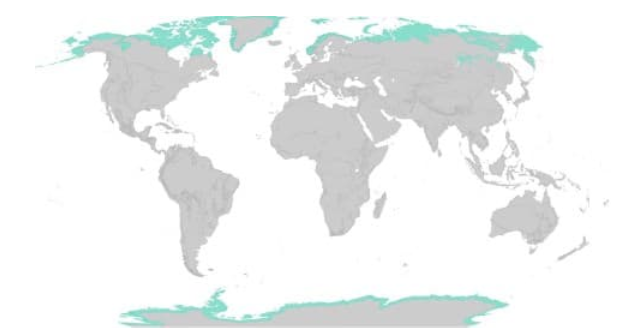
Climate
Temperature: Extremely low annual temperatures, where only a few months experience temperatures above freezing. Ground remains frozen for most of the year, with severe, lengthy winters and brief, cool summers.
Precipitation: Primarily in the form of snow, particularly during winter and in the form of rain or sleet during summer. Convectional rainfall is generally absent due to the cold polar air's low moisture content.
Natural Vegetation
- Severe climatic conditions limit the variety of vegetation.
- The extremely short growing season of less than three months and lack of heat and energy permit only the lowest forms of vegetation like mosses, lichens, sedges, and stunted shrubs.
- During the brief summers, when snow melts, Arctic flowers, and berry bushes briefly bloom, brightening the landscape.
Human Activities
- Inhabitation: Human activities are mainly coastal, as the high-altitude plateaus and mountains are uninhabitable due to perpetual snow cover.
- Eskimos and Nomadic Tribes: Inhabited by Eskimos in Greenland, northern Canada, and Alaska, as well as nomadic tribes like the Lapps of Scandinavia, Samoyeds, Yakuts, Koryaks, and Chukchi in Eurasian tundra.
- They have a semi-nomadic lifestyle, surviving on hunting, fishing, and food-gathering.
Recent Development
- The region's economic importance has grown due to the discovery of minerals.
- New settlements, railway lines, and ports have been established to transport ores, timber, and fur.
- The Polar Climate remains a harsh and challenging environment, primarily inhabited by indigenous peoples and home to a limited array of vegetation due to the extreme conditions. Yet, due to recent discoveries of minerals, the region's economic importance has grown, prompting some developments to support its economic activities.
Frequently Asked Questions (FAQs) about World Climatic Regions:
1. What are the major characteristics of the Hot Wet Equatorial Climate?
Ans. Geographical Distribution: It spans from 50 degrees North to 100 degrees South from the equator.
Climate: Consistently hot and wet with minimal temperature variations and double rainfall peaks.
Natural Vegetation: Known for lush tropical rainforests, rich in diverse vegetation.
Economy: Typically thinly populated, practicing traditional hunting, gathering, and plantation farming.
2. Where is the Tropical Wet and Dry Savanna Climate predominantly found?
Ans. Geographical Distribution: Extends between the Tropic of Cancer and Tropic of Capricorn.
Temperature: Varies between 20 to 32 degrees Celsius, experiencing marked dry and wet seasons.
Vegetation: Comprises tall grasslands, some trees near rivers, and adaptations to conserve water during dry periods.
Wildlife: Home to a variety of herbivores and carnivores, along with reptiles in marshy areas.
3. What defines the Tropical Monsoon Climate?
Ans. Geographical Distribution: Located between 5–30 degrees latitudes on both sides of the equator.
Winds: Seasonal winds known as monsoons lead to temperature and precipitation changes.
Seasons: Three distinct seasons: hot dry, rainy, and cold dry, affecting vegetation and agriculture.
Monsoon Forests: Forests with deciduous trees adapted for the shedding of leaves during dry seasons.
4. What are the defining characteristics of the Desert Climate?
Ans. Distribution: Found between latitudes 15 to 30 degrees north and south in hot deserts.
Climate: High temperatures with minimal rainfall, sparse vegetation adapted to arid conditions.
Vegetation and Life: Xerophytic scrub and varied forms of human settlements.
5. Where are Steppes or Temperate Grasslands primarily located?
Ans. Distribution: Situated in continental interiors within temperate latitudes.
Precipitation: Annual rainfall varies from 25 to 75 cm, with high agricultural productivity.
Vegetation: Vast treeless grasslands with rich agricultural landscapes, conducive to livestock rearing and crop cultivation.
6. What regions exhibit the Mediterranean Climate?
Ans. Distribution: Found in regions like Central Chile, California, southwestern Africa, and southern Australia.
Climate: Warm, dry summers and wet, cold winters marked by local winds and sparse vegetation.
Economy: Agriculture, including fruit cultivation, crop production, and viticulture, significantly contributes to the local economy.
7. Describe the Warm Temperate Eastern Margin Climate.
Ans. Climate: Features warm, moist summers and cool, dry winters with adequate rainfall.
Vegetation: Supports a rich variety of perennial plant growth with a focus on agriculture.
Economic Development: Agriculturally productive regions with significant rice, corn, cotton, and tobacco cultivation.
8. What characterizes the British Type Climate?
Ans. Climate: Moderately warm summers and mild winters with substantial rainfall throughout the year.
Economic Development: Significant deforestation for lumbering, agriculture, and intensive farming, contributing to industrial development.
Agriculture: Diverse farming practices with a significant focus on market gardening and mixed farming.
9. What are the defining features of the Taiga Climate?
Ans. Distribution: Found in the Northern Hemisphere from approximately 50°N to 70°N.
Climate: Extremely cold and long winters, short cool summers, limited precipitation, and dominated by coniferous forests.
Economy: Lumbering and trapping are primary economic activities due to the harsh climate and forest resources.
10. Where is the Polar Climate located and what distinguishes it?
Ans. Distribution: Predominantly north of the Arctic Circle and in Antarctica in the southern hemisphere.
Climate: Extremely low temperatures throughout the year, with limited vegetation and harsh living conditions.
Human Activities: Inhabited by indigenous peoples with a semi-nomadic lifestyle focused on hunting and fishing.

